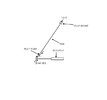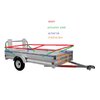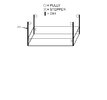I would like to mount some solar panels on my 4x6 trailer to extend and "pop-up" much like one of those popup trailers.
In my region I have googled that the ideal angle will be max at about 5 ft vertical. 57degrees
I and i would like it to drop to 0 ft when travelling(0ft vertical is at the pivot point, along the top of the trailer box).
And want it to tilt in any direction, so i can park trailer in any direction.
I plan on just using some 2x2 lumber for the frame of the mount.
I figure i will get 4-6 pannels on the mount.
I figure the pannels and mount will weigh around 100-200 lbs.
With limited mechanical supplies I figure it will be easiest to use 4 actuators in each corner of the trailer, using the diagram posted,
I figure that will be the easiest configuration. It doesnt seem stable to have it all sitting on a single bar in the center like most mounts i see.
The actuator i found with a low price and high stroke is:
so can i assume that each actuator will need to support 200/4 = 50lbs, plus the fulcrum adjustment(20" = 1.5ft) = 50lbs*(5/1.5) = 166LBS
I dont know if that last paragraph is correct or even made sends(probabally not)? or how to properly calculate? will the actuator posted be enough(900N)? should i use somthing other than 2x2 lumber for mount and arms? is there simpler config? ideas?
thanks!
In my region I have googled that the ideal angle will be max at about 5 ft vertical. 57degrees
I and i would like it to drop to 0 ft when travelling(0ft vertical is at the pivot point, along the top of the trailer box).
And want it to tilt in any direction, so i can park trailer in any direction.
I plan on just using some 2x2 lumber for the frame of the mount.
I figure i will get 4-6 pannels on the mount.
I figure the pannels and mount will weigh around 100-200 lbs.
With limited mechanical supplies I figure it will be easiest to use 4 actuators in each corner of the trailer, using the diagram posted,
I figure that will be the easiest configuration. It doesnt seem stable to have it all sitting on a single bar in the center like most mounts i see.
The actuator i found with a low price and high stroke is:
VEVOR 20 Inch Stroke Linear Actuator 12V DC with Mounting Bracket Heavy Duty 900N 10mm/s Linear Actuator for Recliner TV Table Lift Massage Bed Electric Sofa Linear Actuator : Amazon.ca: Industrial & Scientific
VEVOR 20 Inch Stroke Linear Actuator 12V DC with Mounting Bracket Heavy Duty 900N 10mm/s Linear Actuator for Recliner TV Table Lift Massage Bed Electric Sofa Linear Actuator : Amazon.ca: Industrial & Scientific
www.amazon.ca
so can i assume that each actuator will need to support 200/4 = 50lbs, plus the fulcrum adjustment(20" = 1.5ft) = 50lbs*(5/1.5) = 166LBS
I dont know if that last paragraph is correct or even made sends(probabally not)? or how to properly calculate? will the actuator posted be enough(900N)? should i use somthing other than 2x2 lumber for mount and arms? is there simpler config? ideas?
thanks!





